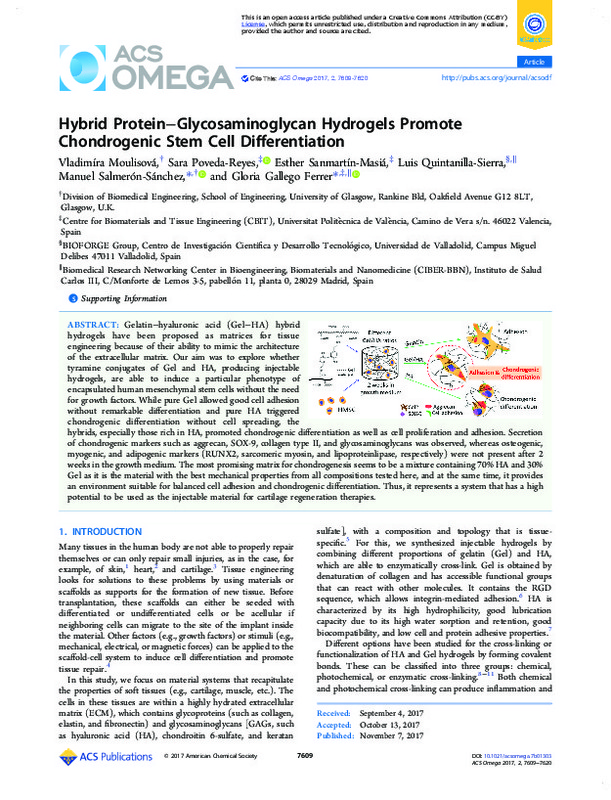JavaScript is disabled for your browser. Some features of this site may not work without it.
Buscar en RiuNet
Listar
Mi cuenta
Estadísticas
Ayuda RiuNet
Admin. UPV
Hybrid Protein-Glycosaminoglycan Hydrogels Promote Chondrogenic Stem Cell Differentiation
Mostrar el registro sencillo del ítem
Ficheros en el ítem
| dc.contributor.author | Moulisova, Vladimira
|
es_ES |
| dc.contributor.author | Poveda-Reyes, Sara
|
es_ES |
| dc.contributor.author | Sanmartin-Masia, Esther
|
es_ES |
| dc.contributor.author | Quintanilla-Sierra, Luis
|
es_ES |
| dc.contributor.author | Ferrer, GG
|
es_ES |
| dc.contributor.author | Salmerón Sánchez, Manuel
|
es_ES |
| dc.date.accessioned | 2020-11-05T04:32:55Z | |
| dc.date.available | 2020-11-05T04:32:55Z | |
| dc.date.issued | 2017-11-07 | es_ES |
| dc.identifier.uri | http://hdl.handle.net/10251/154100 | |
| dc.description.abstract | [EN] Gelatin-hyaluronic acid (Gel-HA) hybrid hydrogels have been proposed as matrices for tissue engineering because of their ability to mimic the architecture of the extracellular matrix. Our aim was to explore whether tyramine conjugates of Gel and HA, producing injectable hydrogels, are able to induce a particular phenotype of encapsulated human mesenchymal stem cells without the need for growth factors. While pure Gel allowed good cell adhesion without remarkable differentiation and pure HA triggered chondrogenic differentiation without cell spreading, the hybrids, especially those rich in HA, promoted chondrogenic differentiation as well as cell proliferation and adhesion. Secretion of chondrogenic markers such as aggrecan, SOX-9, collagen type II, and glycosaminoglycans was observed, whereas osteogenic, myogenic, and adipogenic markers (RUNX2, sarcomeric myosin, and lipoproteinlipase, respectively) were not present after 2 weeks in the growth medium. The most promising matrix for chondrogenesis seems to be a mixture containing 70% HA and 30% Gel as it is the material with the best mechanical properties from all compositions tested here, and at the same time, it provides an environment suitable for balanced cell adhesion and chondrogenic differentiation. Thus, it represents a system that has a high potential to be used as the injectable material for cartilage regeneration therapies. | es_ES |
| dc.description.sponsorship | The authors are grateful for the financial support received from the Spanish Ministry through the MAT2016-76039-C4-1-R project (including the FEDER financial support), the BES-2011-046144, and the EEBB-I-14-08725 grants. The CIBER-BBN initiative is funded by the VI National R&D&I Plan 2008-2011, Iniciativa Ingenio 2010, Consolider Program. CIBER actions are financed by the Instituto de Salud Carlos III with assistance from the European Regional Development Fund. M.S.-S. acknowledges the European Research Council (ERC-HealInSynergy 306990) and the UK Engineering and Physical Sciences Research Council (EPSRC-EP/P001114/1) | es_ES |
| dc.language | Inglés | es_ES |
| dc.publisher | American Chemical Society | es_ES |
| dc.relation.ispartof | ACS Omega | es_ES |
| dc.rights | Reconocimiento (by) | es_ES |
| dc.subject | Biochemistry | es_ES |
| dc.subject | Cell and Molecular biology | es_ES |
| dc.subject | Extracellular matrix proteins | es_ES |
| dc.subject | Hydrogels | es_ES |
| dc.subject | Physical and chemical processes | es_ES |
| dc.subject | Tissue engineering | es_ES |
| dc.subject.classification | MAQUINAS Y MOTORES TERMICOS | es_ES |
| dc.subject.classification | TERMODINAMICA APLICADA (UPV) | es_ES |
| dc.subject.classification | FISICA APLICADA | es_ES |
| dc.title | Hybrid Protein-Glycosaminoglycan Hydrogels Promote Chondrogenic Stem Cell Differentiation | es_ES |
| dc.type | Artículo | es_ES |
| dc.identifier.doi | 10.1021/acsomega.7b01303 | es_ES |
| dc.relation.projectID | info:eu-repo/grantAgreement/EC/FP7/306990/EU/Material-driven Fibronectin Fibrillogenesis to Engineer Synergistic Growth Factor Microenvironments/ | es_ES |
| dc.relation.projectID | info:eu-repo/grantAgreement/UKRI//EP%2FP001114%2F1/GB/Engineering growth factor microenvironments - a new therapeutic paradigm for regenerative medicine/ | es_ES |
| dc.relation.projectID | info:eu-repo/grantAgreement/MINECO//EEBB-I-14-08725/ES/EEBB-I-14-08725/ | es_ES |
| dc.relation.projectID | info:eu-repo/grantAgreement/MICINN//BES-2011-046144/ES/BES-2011-046144/ | es_ES |
| dc.relation.projectID | info:eu-repo/grantAgreement/MINECO//MAT2016-76039-C4-1-R/ES/BIOMATERIALES PIEZOELECTRICOS PARA LA DIFERENCIACION CELULAR EN INTERFASES CELULA-MATERIAL ELECTRICAMENTE ACTIVAS/ | es_ES |
| dc.rights.accessRights | Abierto | es_ES |
| dc.contributor.affiliation | Universitat Politècnica de València. Departamento de Termodinámica Aplicada - Departament de Termodinàmica Aplicada | es_ES |
| dc.contributor.affiliation | Universitat Politècnica de València. Departamento de Física Aplicada - Departament de Física Aplicada | es_ES |
| dc.description.bibliographicCitation | Moulisova, V.; Poveda-Reyes, S.; Sanmartin-Masia, E.; Quintanilla-Sierra, L.; Ferrer, G.; Salmerón Sánchez, M. (2017). Hybrid Protein-Glycosaminoglycan Hydrogels Promote Chondrogenic Stem Cell Differentiation. ACS Omega. 2(11):7609-7620. https://doi.org/10.1021/acsomega.7b01303 | es_ES |
| dc.description.accrualMethod | S | es_ES |
| dc.relation.publisherversion | https://doi.org/10.1021/acsomega.7b01303 | es_ES |
| dc.description.upvformatpinicio | 7609 | es_ES |
| dc.description.upvformatpfin | 7620 | es_ES |
| dc.type.version | info:eu-repo/semantics/publishedVersion | es_ES |
| dc.description.volume | 2 | es_ES |
| dc.description.issue | 11 | es_ES |
| dc.identifier.eissn | 2470-1343 | es_ES |
| dc.identifier.pmid | 29214232 | es_ES |
| dc.identifier.pmcid | PMC5709783 | es_ES |
| dc.relation.pasarela | S\358990 | es_ES |
| dc.contributor.funder | UK Research and Innovation | es_ES |
| dc.contributor.funder | Engineering and Physical Sciences Research Council, Reino Unido | es_ES |
| dc.contributor.funder | Ministerio de Ciencia e Innovación | es_ES |
| dc.contributor.funder | Ministerio de Economía y Competitividad | es_ES |








